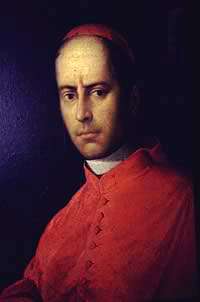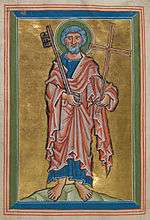Lay cardinal

| Part of a series on the |
| Hierarchy of the Catholic Church |
|---|
 |
| Ecclesiastical titles |
|
|
Liturgical titles |
|
Administrative and pastoral titles
|
|
Consecrated and professed titles |
|
|
In the Roman Catholic Church, a "lay cardinal" was a cardinal who had never been given major orders, i.e. who had never been ordained a deacon, priest, or bishop.
Properly speaking these cardinals were not laymen, since they were all given what was called first tonsure, by which at that time one became a cleric and ceased being a layman.[1] In addition they were given minor orders, which were no obstacle to marrying or to living in a marriage previously contracted. The freedom to marry and to live in marriage is doubtless the reason that cardinals who were not in major orders were popularly, though inaccurately, referred to as lay cardinals.
Examples
Ferdinando I de' Medici was a lay cardinal for twenty-six years. Even after he succeeded his brother Francesco I de' Medici as Grand Duke of Tuscany in 1587, he nevertheless remained a cardinal until he married Christina of Lorraine two years later.
Francisco Gómez de Sandoval, 1st Duke of Lerma was created cardinal by Pope Paul V on March 26, 1618,[2] a title that protected him from prosecution, after he was banished from power on October 4, 1618.
Cardinal-Infante Ferdinand of Austria was a lay cardinal for about 20 years from 1620 (about age 10) to his death in 1641.
Teodolfo Mertel, a lawyer and layman, was named cardinal by Pope Pius IX in 1858. He was not a lay cardinal for long, as he received ordination to the diaconate the same year. When he died in 1899 he was the last non-priest cardinal.[3] (Giacomo Antonelli, who died in 1876 as Pius IX's Cardinal Secretary of State, remained a deacon when named cardinal in 1847.)
In 1968 Pope Paul VI seriously considered appointing the French Catholic philosopher Jacques Maritain a lay cardinal.
Confusion concerning the title of "cardinal"
It is perhaps commonplace to think that the title of "cardinal" is the next order after "bishop" to which a man may be ordained, as "bishop" comes after "priest" and "priest" after "deacon". In fact, however, the position of cardinal is not an order to which one can be ordained; rather, a cardinal is simply an elector of the pope and the title is an honorific office in the Church independent of the priesthood.
The original "cardinals" in the first Christian centuries were friends and counsellors of the Bishop of Rome. Some were ordained deacons or priests and some were not. In those days of persecution these men took on the duty of standing at the door of the house where the agapē feast, as the Mass was then called, was being celebrated. They admitted or rejected people hoping to attend the Sacred Liturgy. They also kept watch for soldiers or informers who might interrupt the gathering. Since the word for "hinge" in Latin is cardo they became known as 'hingemen" – cardinals. Soon many bishops called their advisors "cardinals" but, in time, the Pope decreed that only the advisors of the Bishop of Rome could be known by the title "cardinal".
Changes in canon law
The 1917 Code of Canon Law decreed that from then on only those who were priests or bishops could be chosen as cardinals,[4] thus officially closing the historical period in which some cardinals could be clergy who had only received first tonsure and minor orders.
The same rule is repeated in the 1983 Code of Canon Law, which adds that those who are not already bishops are to receive episcopal ordination.[5] Any priest who has been nominated for the cardinalate may ask for dispensation from the obligation to be ordained to the episcopacy before being created Cardinal, but in practice it is usually Jesuits who ask for and are granted this dispensation. For example, the dispensation was requested by the theologian Avery Dulles upon being named cardinal by Pope John Paul II in 2001 who granted it. Subsequently invited to a meeting of the United States Conference of Catholic Bishops (USCCB) in 2002, Cardinal Dulles at one point asked for recognition to speak to the bishops from the floor. His quip that he was there "under false pretenses" was greeted by much laughter.
The same dispensation was granted to Roberto Tucci, another esteemed theologian from the Society of Jesus: he was created cardinal in the consistory of 21 February 2001 by Pope John Paul II, whom Tucci had also successfully petitioned not to be ordained to the episcopacy.
With the motu proprio Ministeria quaedam of 15 August 1972 Pope Paul VI ended the conferral of first tonsure and laid down that entry into the clerical state would instead be by ordination as deacon.[6]
See also
- Crown cardinal
- Cardinal protector
- Cardinal-Infante (disambiguation)
- Cardinal-nephew
- Tonsure
- Minor orders
References
- ↑ Cf. canon 108 of the 1917 Code of Canon Law
- ↑ Antonio Feros. El Duque de Lerma: realeza y privanza en la España de Felipe III. Page 429
- ↑ http://www.catholic-hierarchy.org/bishop/bmert.html
- ↑ canon 232 §1
- ↑ canon 351§1
- ↑ Ministeria quaedam